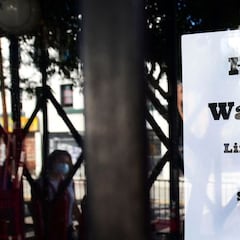How does the current rate of 375,000 weekly jobless claims compare to the rest of the pandemic?
The US jobs market has been in a state of flux throughout the pandemic with employers initially forced to lay workers off, but the economy does seem to be recovering.


Last Thursday the Labor Department announced that the total number of new claims for unemployment support in the United States during the previous week had totalled 375,000, the third consecutive week of decline.
Since businesses were able to reopen in the spring the economic recovery has gathered pace and the number of new jobless claims has settled just below 400,000, with a four-week average of 396,250.
new #jobless claims declined by 12,000 to 375,000 during the week ending 7 August. Continuing claims declined by 114,000 to 2.866 million and the insured #unemployment rate for the week ending 31 July fell 0.1 percentage points to 2.1%. pic.twitter.com/bpXYVVZNiV
— Dr Thomas Kevin Swift (@DrTKSwift) August 12, 2021
The latest figures relate to the first week of August and were released shortly after the July jobs report came out, suggesting that the jobs market had made considerable gains. With the pandemic unemployment benefits now withdrawn in some states there was some suggestion that this may encourage workers back to the workplace, but the rate of employment has actually increased more in areas where the additional support is still on offer.
How has unemployment varied during the pandemic?
As well as there being fewer new claims, the total number of Americans requiring insured unemployment, a measure of continuing joblessness, fell to 2.866 million at the end of July. That represents the lowest level recorded since mid-March 2020, when the pandemic really took hold.
Over the past 18 months unemployment has been one of the biggest economic challenges facing the United States with joblessness soaring in the spring of 2020. In April of that year the national unemployment rate reached 14.8%, the highest figure recorded since the Congressional Research Service began collecting data in 1948.
April 2020 also law labour force participation decline to 60.2%, the lowest seen since the early 1970s. Between January and April of last year the US jobs market lost an estimated 22.1 million nonfarm payroll jobs, causing the rapid rise in unemployment and the related jobless claims.
The July jobs report was universally hailed as a good one. But as the delta variant surges, there's worry the good news could be fleeting. Here are five takeaways from the July jobs report. https://t.co/uOWp4k83ag
— The Associated Press (@AP) August 7, 2021
However while the current data suggests that the US job market’s recovery is continuing to show promise there is concern that a re-emergence of covid-19 could bring that skidding to a halt. The Delta variant has been a particular focus for local government and health officials in recent months with some choosing to re-impose some coronavirus restrictions to curb the spread of the more infectious variant.
Related stories
Reflecting on the latest figures, Sam Bullard, senior economist for Wells Fargo, was cautious about the “strong GDP growth and a recovering labour market.”
He said: "The Delta variant, which has led to a surge in hospitalisations and a rise in deaths attributed to covid, has to be monitored and poses downside risk to the growth and labour market outlooks - especially if plans to bring back office workers and re-open schools this fall are delayed."

